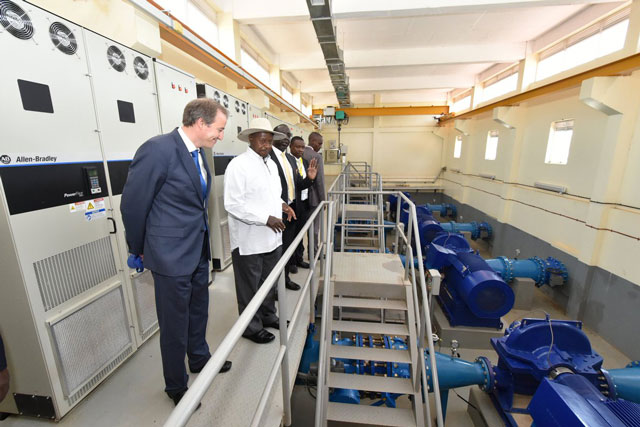
Uganda’s journey to secure clean, adequate fresh water for all
COMMENT | JOSHUA MUSHWA | “Water is the driving force of all nature” is a popular phrase coined by Leonardo da Vinci which underscores the value of water as a key source that every living organism on this planet depends on. A lack of safe water affects every aspect of life. Without it, a lot of health and sanitation related challenges become pervasive in society, children’s education or learning is adversely affected since some of them have to trek long distances to fetch water which leads them to missing school and sustainable agriculture becomes practically difficult without adequate water access.
As such, the government of Uganda found it absolutely vital to prioritize access to clean water and has recorded tremendous landmarks in the Water and Environment Sector.
The Ugandan water supply and sanitation sector has made substantial progress in urban areas from the mid-1990s to-date, with substantial increases in coverage as well as in operational and commercial performance.
As of June 2018, the percentage of Uganda’s rural population with access to safe water was estimated to be 70% compared to 39% in 1990. Access to safe drinking water in urban areas has increased to 74% and management of water and sanitation by National Water and Sewerage Corporation has expanded to cover a total of 238 towns.
Although there is still a lot to be done in the Sanitation and Hygiene sector across the country, there has been tremendous improvement with most districts in Uganda implementing Community Led Total Sanitation (CLTS) and Home Improvement Campaigns (HIC) to improve their sanitation and hygiene status. According to district reports, access to rural (basic) sanitation is currently at 80% and 86% for urban areas.
Agriculture in Africa entirely depends on water and so it makes it strenuous to achieve sustainable agriculture without water access. As such the government of Uganda through the Ministry of Water and Environment embarked on constructing and rehabilitating earth dams and valley tanks country-wide mainly in the cattle corridor with an aim of making adequate water available to the pastoral communities in a more sustainable manner.
Commissioned a new water plant in Ggaba. It will add 50m litres of water daily to Kampala, bringing total supply to 240 million litres. pic.twitter.com/78v63tH8QQ
— Yoweri K Museveni (@KagutaMuseveni) January 24, 2017
The gradual impacts of climate change and population pressure on land use, are beginning to have a remarkably adverse impact on agricultural productivity but Since Uganda has one of the highest irrigation potential in the world with over 15% of her surface area covered by fresh water resources, the NRM Government took advantage of this to ensure optimal use of available land and water resources for agricultural production and productivity to contribute effectively towards food security and export promotion.
Some of the irrigation schemes established by President Museveni’s government include; Mubuku irrigation settlement scheme in the Kasese District which was established in 1998 as a settlement scheme with gravity irrigation and water intakes from Sebwe and Mubuku rivers.
The Kiige scheme in the Kamuli District has Lake Nabigaga as a water source for sprinkler irrigation of citrus fruits was established in 1998. The Labori and Odina schemes abstracting water from Lake Kyoga for sprinkler irrigation.
The Ongom scheme in the Lira District is a sprinkler irrigation scheme for citrus fruits and was established in 1998. The Atera irrigation scheme in the Apac District was designed to abstract water from the Nile through pumping and subsequent gravitational flow through pipes and water hydrants to the fields. The Agoro self-help irrigation project in the Kitgum District is a gravity-fed scheme with intake from the Agoro River established in 1998 and the Olweny swamp rice irrigation project in 2001. As of today, government is working on over 17 new irrigation schemes in different districts across the country
As the effects of lack of clean water to women became apparent, the NRM government made effort in boosting water supply through a massive water extension roll out programs that has seen NWSC increase service coverage from 23 towns in 2013 to now over 240 towns across the country. Due to this, millions of women can now engage more in productive activities.
Contrary to popular belief, water conservation is everyone’s responsibility. Many people believe that we have plenty of water in the world yet most of it is not drinkable. Only 3% of the earth’s water is fresh water and 2/3 of this is bound up in glaciers and icecaps. That leaves only 1% of the world’s water available for drinking. With a fast-growing population where the demand of clean and sufficient water is increasing everyday there is need for Ugandans to use water sparingly.
As we approach the 33rd commemoration of the Liberation Day, as a passionate environmentalist I am convinced that it is a day worthy of celebration by all Ugandans regardless of political affiliation because among the very many gains and strides made by the NRM government, our environment and most specifically clean water supply across the country at this point in time is far much better than it was 33 years ago.
****
Mr Joshua Mushwa works as a Communications Assistant at the Government Citizens Interaction Centre, Ministry of ICT & National Guidance.
 The Independent Uganda: You get the Truth we Pay the Price
The Independent Uganda: You get the Truth we Pay the Price



What’s up, this weekend is nice in support of me, since this time i
am reading this enormous informative article here at my residence.
۱۰ سامانه برتر خرید اینترنتی بلیط هواپیما، قطار و اتوبوس …
Many thanks for your assistance in our project.